sensor CADILLAC STS 2006 1.G User Guide
[x] Cancel search | Manufacturer: CADILLAC, Model Year: 2006, Model line: STS, Model: CADILLAC STS 2006 1.GPages: 480, PDF Size: 2.74 MB
Page 191 of 480

How the System Works
URPA comes on automatically when the shift lever is
moved into REVERSE (R) and the vehicle speed is less
than 3 mph (5 km/h). When the system turns on, the
three lights on the display will illuminate for one and a
half seconds to let you know that the system is
working. If your vehicle is moving in REVERSE (R) at a
speed greater than 3 mph (5 km/h), the red light will
�ash to remind you that the system does not work at a
speed greater than 3 mph (5 km/h).
If an object is detected at a REVERSE (R) speed of
less than 3 mph (5 km/h), one of the following will occur:
Description English Metric
Amber light 5 ft 1.5 m
Amber/amber lights 40 in 1.0 m
Amber/amber/red lights &
continuous chime20 in 0.5 m
Amber/amber/red lights
�ashing & continuous
chime1 ft 0.3 m
A chime will sound the �rst time an object is detected
between 20 inches (0.5 m) and 5 feet (1.5 m) away.
URPA cannot detect objects that are above trunk level.
In order for the rear sensors to recognize an object,
it must be within detection range behind the vehicle.
When the System Does Not Seem to
Work Properly
The light may �ash red when the vehicle is in
REVERSE (R), if the ultrasonic sensors are not kept
clean. So be sure to keep your rear bumper free of mud,
dirt, snow, ice and slush. Other conditions that may
affect system performance include things like the
vibrations from a jackhammer or the compression of air
brakes on a very large truck. If after cleaning the
rear bumper and then driving forward at least 15 mph
(25 km/h), the display continues to �ash red, see
your dealer.
If a trailer was attached to your vehicle, or a bicycle or
an object was hanging out of your trunk during your
last drive cycle, the light may also �ash red. The light will
continue to �ash whenever in REVERSE (R) until
your vehicle is driven forward at least 15 mph (25 km/h)
without any obstructions behind the vehicle.
For cleaning instructions, seeWashing Your Vehicle on
page 5-98.
3-45
Page 194 of 480
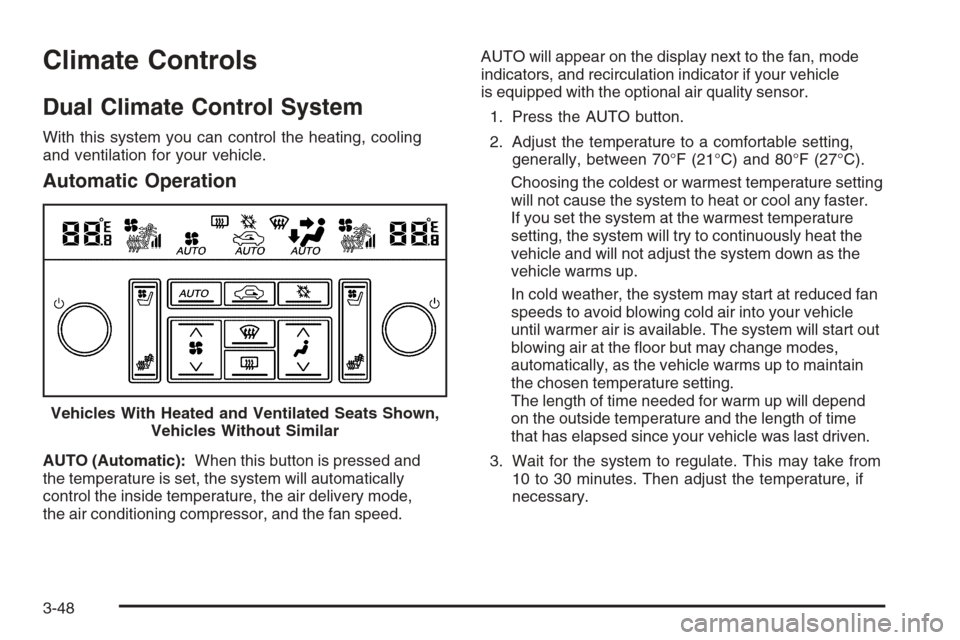
Climate Controls
Dual Climate Control System
With this system you can control the heating, cooling
and ventilation for your vehicle.
Automatic Operation
AUTO (Automatic):When this button is pressed and
the temperature is set, the system will automatically
control the inside temperature, the air delivery mode,
the air conditioning compressor, and the fan speed.AUTO will appear on the display next to the fan, mode
indicators, and recirculation indicator if your vehicle
is equipped with the optional air quality sensor.
1. Press the AUTO button.
2. Adjust the temperature to a comfortable setting,
generally, between 70°F (21°C) and 80°F (27°C).
Choosing the coldest or warmest temperature setting
will not cause the system to heat or cool any faster.
If you set the system at the warmest temperature
setting, the system will try to continuously heat the
vehicle and will not adjust the system down as the
vehicle warms up.
In cold weather, the system may start at reduced fan
speeds to avoid blowing cold air into your vehicle
until warmer air is available. The system will start out
blowing air at the �oor but may change modes,
automatically, as the vehicle warms up to maintain
the chosen temperature setting.
The length of time needed for warm up will depend
on the outside temperature and the length of time
that has elapsed since your vehicle was last driven.
3. Wait for the system to regulate. This may take from
10 to 30 minutes. Then adjust the temperature, if
necessary. Vehicles With Heated and Ventilated Seats Shown,
Vehicles Without Similar
3-48
Page 196 of 480
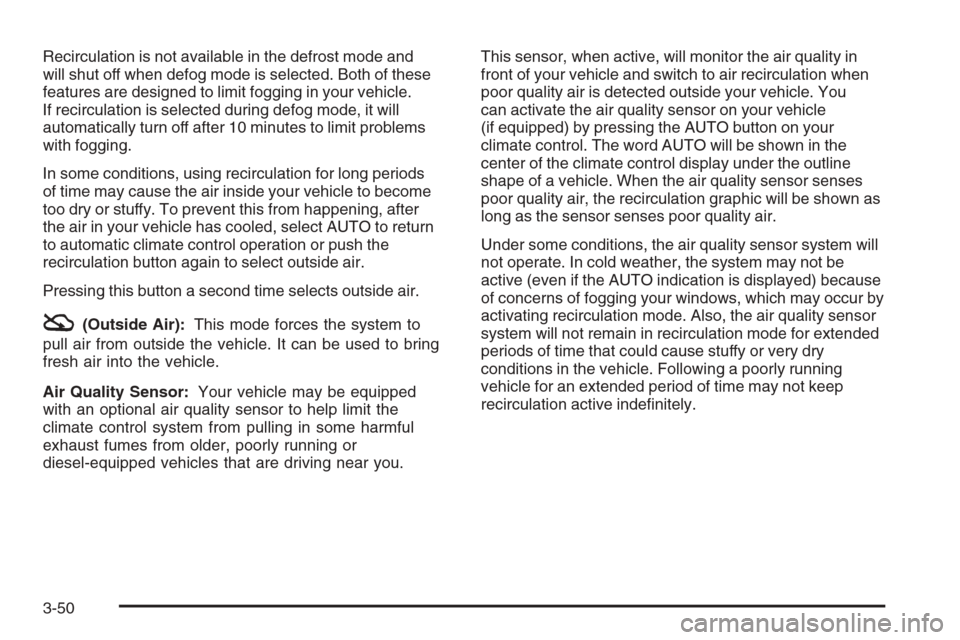
Recirculation is not available in the defrost mode and
will shut off when defog mode is selected. Both of these
features are designed to limit fogging in your vehicle.
If recirculation is selected during defog mode, it will
automatically turn off after 10 minutes to limit problems
with fogging.
In some conditions, using recirculation for long periods
of time may cause the air inside your vehicle to become
too dry or stuffy. To prevent this from happening, after
the air in your vehicle has cooled, select AUTO to return
to automatic climate control operation or push the
recirculation button again to select outside air.
Pressing this button a second time selects outside air.
:(Outside Air):This mode forces the system to
pull air from outside the vehicle. It can be used to bring
fresh air into the vehicle.
Air Quality Sensor:Your vehicle may be equipped
with an optional air quality sensor to help limit the
climate control system from pulling in some harmful
exhaust fumes from older, poorly running or
diesel-equipped vehicles that are driving near you.This sensor, when active, will monitor the air quality in
front of your vehicle and switch to air recirculation when
poor quality air is detected outside your vehicle. You
can activate the air quality sensor on your vehicle
(if equipped) by pressing the AUTO button on your
climate control. The word AUTO will be shown in the
center of the climate control display under the outline
shape of a vehicle. When the air quality sensor senses
poor quality air, the recirculation graphic will be shown as
long as the sensor senses poor quality air.
Under some conditions, the air quality sensor system will
not operate. In cold weather, the system may not be
active (even if the AUTO indication is displayed) because
of concerns of fogging your windows, which may occur by
activating recirculation mode. Also, the air quality sensor
system will not remain in recirculation mode for extended
periods of time that could cause stuffy or very dry
conditions in the vehicle. Following a poorly running
vehicle for an extended period of time may not keep
recirculation active inde�nitely.
3-50
Page 197 of 480
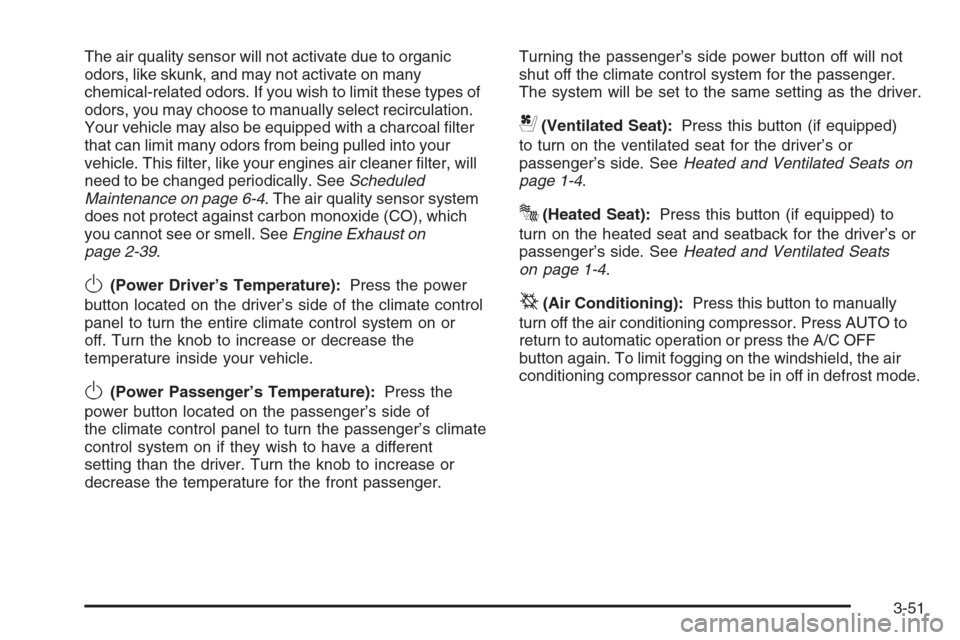
The air quality sensor will not activate due to organic
odors, like skunk, and may not activate on many
chemical-related odors. If you wish to limit these types of
odors, you may choose to manually select recirculation.
Your vehicle may also be equipped with a charcoal �lter
that can limit many odors from being pulled into your
vehicle. This �lter, like your engines air cleaner �lter, will
need to be changed periodically. SeeScheduled
Maintenance on page 6-4. The air quality sensor system
does not protect against carbon monoxide (CO), which
you cannot see or smell. SeeEngine Exhaust on
page 2-39.
O(Power Driver’s Temperature):Press the power
button located on the driver’s side of the climate control
panel to turn the entire climate control system on or
off. Turn the knob to increase or decrease the
temperature inside your vehicle.
O(Power Passenger’s Temperature):Press the
power button located on the passenger’s side of
the climate control panel to turn the passenger’s climate
control system on if they wish to have a different
setting than the driver. Turn the knob to increase or
decrease the temperature for the front passenger.Turning the passenger’s side power button off will not
shut off the climate control system for the passenger.
The system will be set to the same setting as the driver.
{(Ventilated Seat):Press this button (if equipped)
to turn on the ventilated seat for the driver’s or
passenger’s side. SeeHeated and Ventilated Seats on
page 1-4.
J(Heated Seat):Press this button (if equipped) to
turn on the heated seat and seatback for the driver’s or
passenger’s side. SeeHeated and Ventilated Seats
on page 1-4.
^(Air Conditioning):Press this button to manually
turn off the air conditioning compressor. Press AUTO to
return to automatic operation or press the A/C OFF
button again. To limit fogging on the windshield, the air
conditioning compressor cannot be in off in defrost mode.
3-51
Page 198 of 480
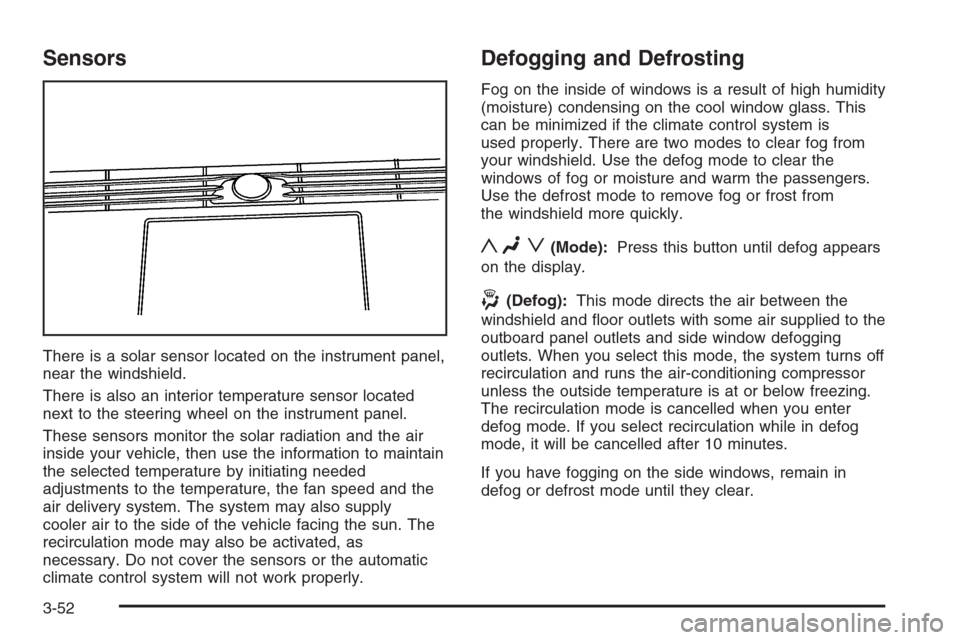
Sensors
There is a solar sensor located on the instrument panel,
near the windshield.
There is also an interior temperature sensor located
next to the steering wheel on the instrument panel.
These sensors monitor the solar radiation and the air
inside your vehicle, then use the information to maintain
the selected temperature by initiating needed
adjustments to the temperature, the fan speed and the
air delivery system. The system may also supply
cooler air to the side of the vehicle facing the sun. The
recirculation mode may also be activated, as
necessary. Do not cover the sensors or the automatic
climate control system will not work properly.
Defogging and Defrosting
Fog on the inside of windows is a result of high humidity
(moisture) condensing on the cool window glass. This
can be minimized if the climate control system is
used properly. There are two modes to clear fog from
your windshield. Use the defog mode to clear the
windows of fog or moisture and warm the passengers.
Use the defrost mode to remove fog or frost from
the windshield more quickly.
yNz(Mode):Press this button until defog appears
on the display.
-(Defog):This mode directs the air between the
windshield and �oor outlets with some air supplied to the
outboard panel outlets and side window defogging
outlets. When you select this mode, the system turns off
recirculation and runs the air-conditioning compressor
unless the outside temperature is at or below freezing.
The recirculation mode is cancelled when you enter
defog mode. If you select recirculation while in defog
mode, it will be cancelled after 10 minutes.
If you have fogging on the side windows, remain in
defog or defrost mode until they clear.
3-52
Page 206 of 480
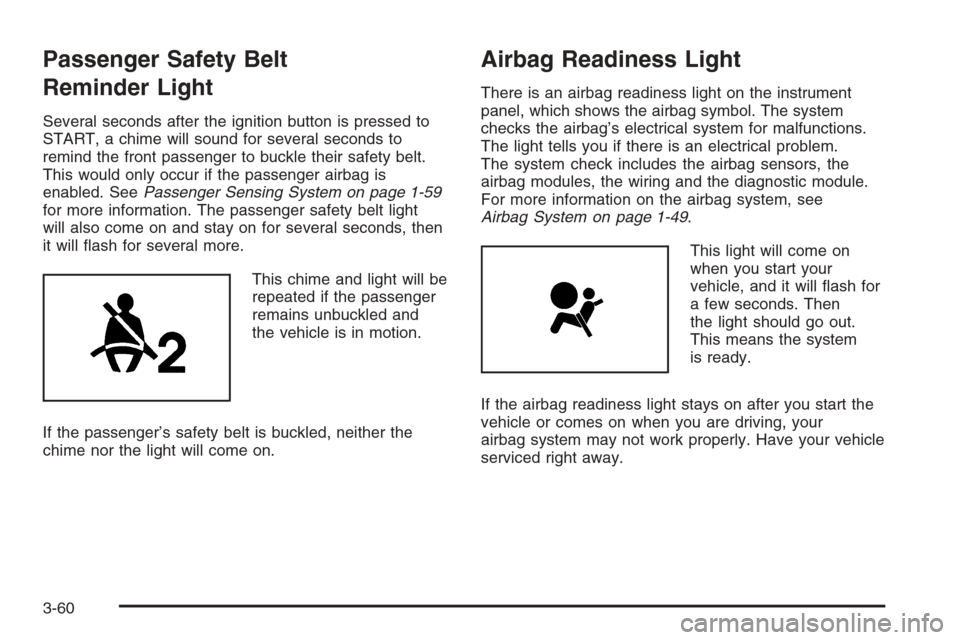
Passenger Safety Belt
Reminder Light
Several seconds after the ignition button is pressed to
START, a chime will sound for several seconds to
remind the front passenger to buckle their safety belt.
This would only occur if the passenger airbag is
enabled. SeePassenger Sensing System on page 1-59
for more information. The passenger safety belt light
will also come on and stay on for several seconds, then
it will �ash for several more.
This chime and light will be
repeated if the passenger
remains unbuckled and
the vehicle is in motion.
If the passenger’s safety belt is buckled, neither the
chime nor the light will come on.
Airbag Readiness Light
There is an airbag readiness light on the instrument
panel, which shows the airbag symbol. The system
checks the airbag’s electrical system for malfunctions.
The light tells you if there is an electrical problem.
The system check includes the airbag sensors, the
airbag modules, the wiring and the diagnostic module.
For more information on the airbag system, see
Airbag System on page 1-49.
This light will come on
when you start your
vehicle, and it will �ash for
a few seconds. Then
the light should go out.
This means the system
is ready.
If the airbag readiness light stays on after you start the
vehicle or comes on when you are driving, your
airbag system may not work properly. Have your vehicle
serviced right away.
3-60
Page 234 of 480
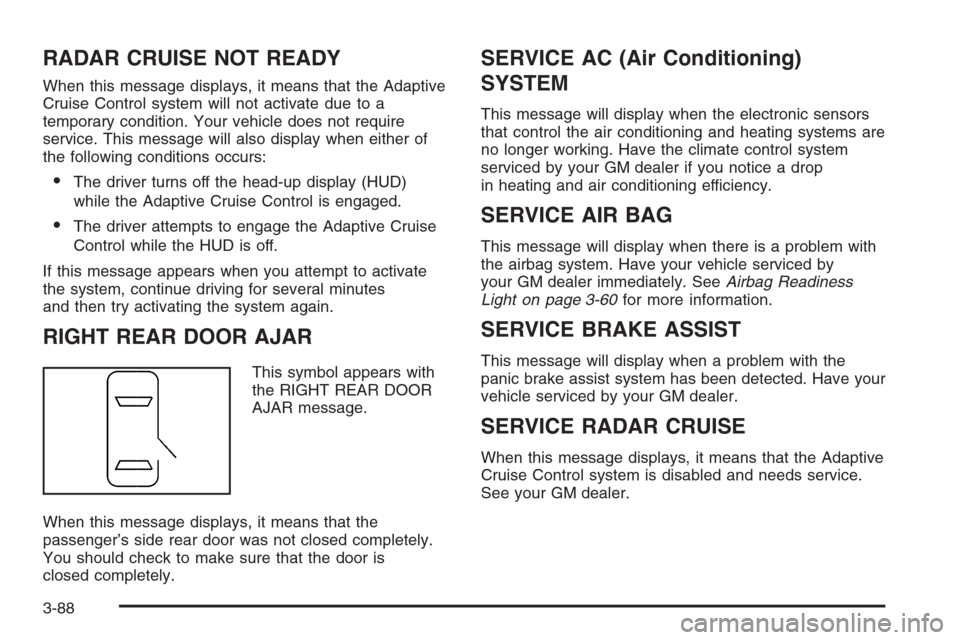
RADAR CRUISE NOT READY
When this message displays, it means that the Adaptive
Cruise Control system will not activate due to a
temporary condition. Your vehicle does not require
service. This message will also display when either of
the following conditions occurs:
The driver turns off the head-up display (HUD)
while the Adaptive Cruise Control is engaged.
The driver attempts to engage the Adaptive Cruise
Control while the HUD is off.
If this message appears when you attempt to activate
the system, continue driving for several minutes
and then try activating the system again.
RIGHT REAR DOOR AJAR
This symbol appears with
the RIGHT REAR DOOR
AJAR message.
When this message displays, it means that the
passenger’s side rear door was not closed completely.
You should check to make sure that the door is
closed completely.
SERVICE AC (Air Conditioning)
SYSTEM
This message will display when the electronic sensors
that control the air conditioning and heating systems are
no longer working. Have the climate control system
serviced by your GM dealer if you notice a drop
in heating and air conditioning efficiency.
SERVICE AIR BAG
This message will display when there is a problem with
the airbag system. Have your vehicle serviced by
your GM dealer immediately. SeeAirbag Readiness
Light on page 3-60for more information.
SERVICE BRAKE ASSIST
This message will display when a problem with the
panic brake assist system has been detected. Have your
vehicle serviced by your GM dealer.
SERVICE RADAR CRUISE
When this message displays, it means that the Adaptive
Cruise Control system is disabled and needs service.
See your GM dealer.
3-88
Page 236 of 480
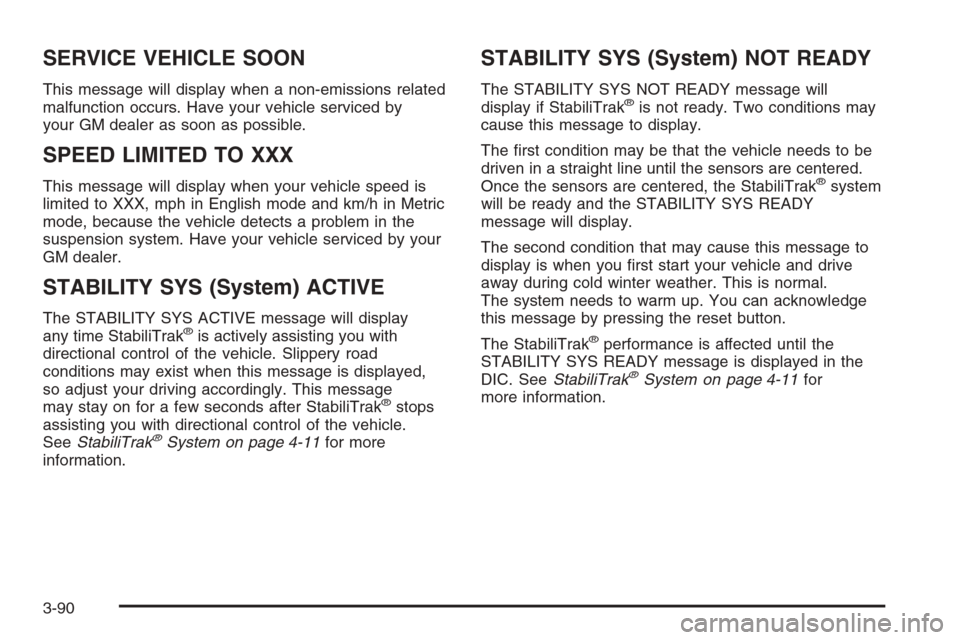
SERVICE VEHICLE SOON
This message will display when a non-emissions related
malfunction occurs. Have your vehicle serviced by
your GM dealer as soon as possible.
SPEED LIMITED TO XXX
This message will display when your vehicle speed is
limited to XXX, mph in English mode and km/h in Metric
mode, because the vehicle detects a problem in the
suspension system. Have your vehicle serviced by your
GM dealer.
STABILITY SYS (System) ACTIVE
The STABILITY SYS ACTIVE message will display
any time StabiliTrak®is actively assisting you with
directional control of the vehicle. Slippery road
conditions may exist when this message is displayed,
so adjust your driving accordingly. This message
may stay on for a few seconds after StabiliTrak
®stops
assisting you with directional control of the vehicle.
SeeStabiliTrak
®System on page 4-11for more
information.
STABILITY SYS (System) NOT READY
The STABILITY SYS NOT READY message will
display if StabiliTrak®is not ready. Two conditions may
cause this message to display.
The �rst condition may be that the vehicle needs to be
driven in a straight line until the sensors are centered.
Once the sensors are centered, the StabiliTrak
®system
will be ready and the STABILITY SYS READY
message will display.
The second condition that may cause this message to
display is when you �rst start your vehicle and drive
away during cold winter weather. This is normal.
The system needs to warm up. You can acknowledge
this message by pressing the reset button.
The StabiliTrak
®performance is affected until the
STABILITY SYS READY message is displayed in the
DIC. SeeStabiliTrak
®System on page 4-11for
more information.
3-90
Page 279 of 480
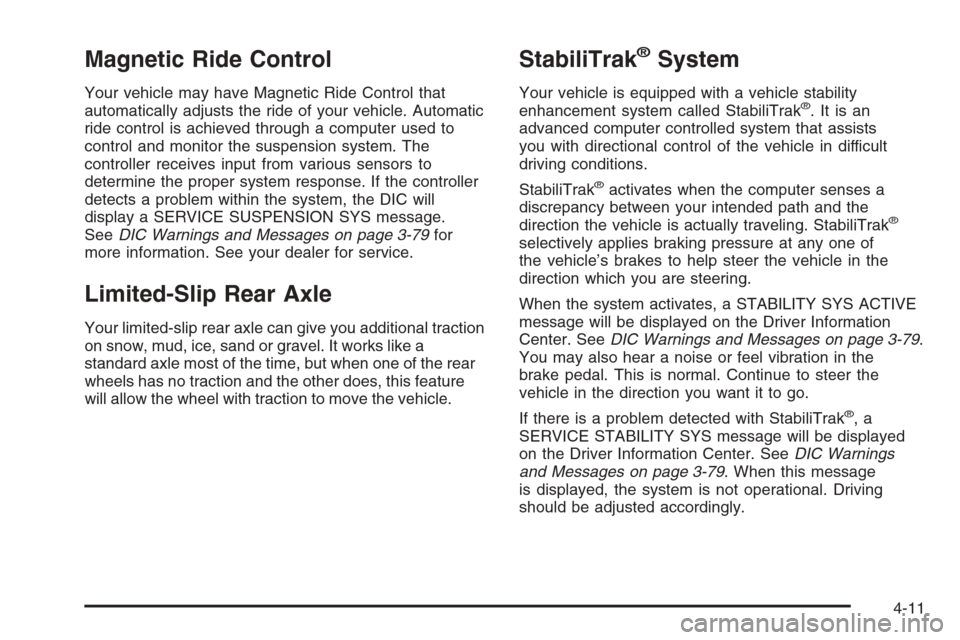
Magnetic Ride Control
Your vehicle may have Magnetic Ride Control that
automatically adjusts the ride of your vehicle. Automatic
ride control is achieved through a computer used to
control and monitor the suspension system. The
controller receives input from various sensors to
determine the proper system response. If the controller
detects a problem within the system, the DIC will
display a SERVICE SUSPENSION SYS message.
SeeDIC Warnings and Messages on page 3-79for
more information. See your dealer for service.
Limited-Slip Rear Axle
Your limited-slip rear axle can give you additional traction
on snow, mud, ice, sand or gravel. It works like a
standard axle most of the time, but when one of the rear
wheels has no traction and the other does, this feature
will allow the wheel with traction to move the vehicle.
StabiliTrak®System
Your vehicle is equipped with a vehicle stability
enhancement system called StabiliTrak®.Itisan
advanced computer controlled system that assists
you with directional control of the vehicle in difficult
driving conditions.
StabiliTrak
®activates when the computer senses a
discrepancy between your intended path and the
direction the vehicle is actually traveling. StabiliTrak
®
selectively applies braking pressure at any one of
the vehicle’s brakes to help steer the vehicle in the
direction which you are steering.
When the system activates, a STABILITY SYS ACTIVE
message will be displayed on the Driver Information
Center. SeeDIC Warnings and Messages on page 3-79.
You may also hear a noise or feel vibration in the
brake pedal. This is normal. Continue to steer the
vehicle in the direction you want it to go.
If there is a problem detected with StabiliTrak
®,a
SERVICE STABILITY SYS message will be displayed
on the Driver Information Center. SeeDIC Warnings
and Messages on page 3-79. When this message
is displayed, the system is not operational. Driving
should be adjusted accordingly.
4-11
Page 378 of 480
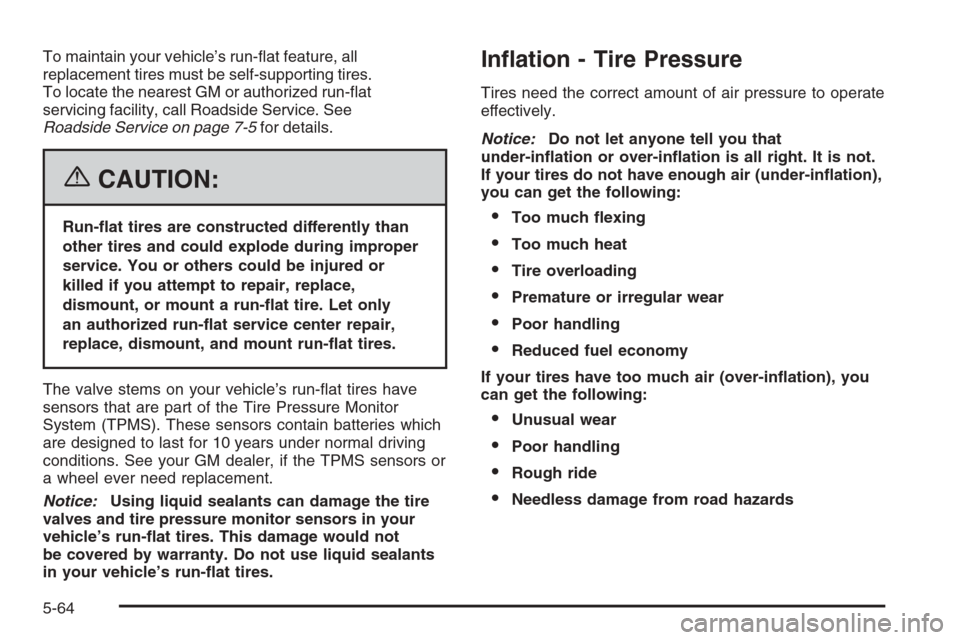
To maintain your vehicle’s run-�at feature, all
replacement tires must be self-supporting tires.
To locate the nearest GM or authorized run-�at
servicing facility, call Roadside Service. See
Roadside Service on page 7-5for details.
{CAUTION:
Run-�at tires are constructed differently than
other tires and could explode during improper
service. You or others could be injured or
killed if you attempt to repair, replace,
dismount, or mount a run-�at tire. Let only
an authorized run-�at service center repair,
replace, dismount, and mount run-�at tires.
The valve stems on your vehicle’s run-�at tires have
sensors that are part of the Tire Pressure Monitor
System (TPMS). These sensors contain batteries which
are designed to last for 10 years under normal driving
conditions. See your GM dealer, if the TPMS sensors or
a wheel ever need replacement.
Notice:Using liquid sealants can damage the tire
valves and tire pressure monitor sensors in your
vehicle’s run-�at tires. This damage would not
be covered by warranty. Do not use liquid sealants
in your vehicle’s run-�at tires.
In�ation - Tire Pressure
Tires need the correct amount of air pressure to operate
effectively.
Notice:Do not let anyone tell you that
under-in�ation or over-in�ation is all right. It is not.
If your tires do not have enough air (under-in�ation),
you can get the following:
Too much �exing
Too much heat
Tire overloading
Premature or irregular wear
Poor handling
Reduced fuel economy
If your tires have too much air (over-in�ation), you
can get the following:
Unusual wear
Poor handling
Rough ride
Needless damage from road hazards
5-64